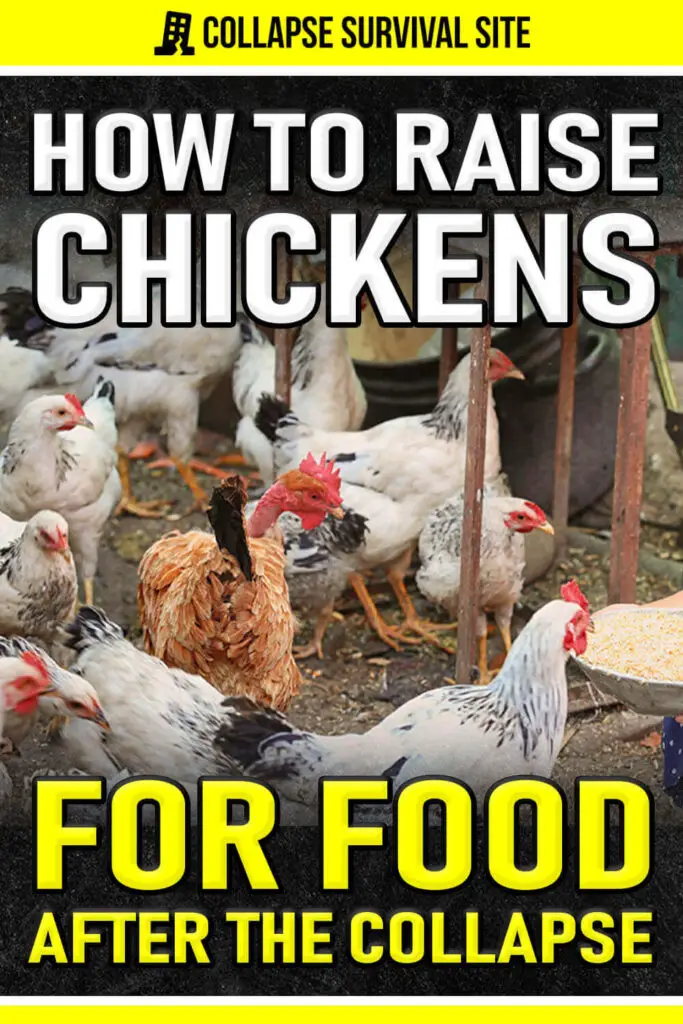Estimated reading time: 12 minutes
Most of us have noticed that the cost of eggs at any grocery store are way beyond anything we’ve paid in the past. The primary cause at this point is a bird-flu outbreak decimating chicken farms. The average price as of December 2022 ranges from $5 to $9 a dozen for eggs depending on where you live and those prices continue to climb.
What’s worth considering is that the day may come when we look back at those prices as a value. Worse, there may be a time where it’s simply impossible to buy the most basic things like eggs due to a variety of factors that could lead to an economic and societal collapse.
Want to save this post for later? Click Here to Pin It On Pinterest!
Say Goodbye to Most Things
Any collapse in any society results in a significant loss of the most basic services and necessities. In the grand scheme of things chickens may seem to be a small impact but both chicken eggs and the chickens themselves represent a significant source of protein from a source that is easy to raise and maintain.
Historically, chickens have been the most common and reliable livestock source for people around the world. Following a collapse chickens may be the only reliable source of animal protein for many of us.
Forget the Old Ideas About Raising Chickens
Anyone who has raised chickens or done any research about how to approach it knows the common tips, cautions and good ideas. Forget about it. All bets are off and the landscape is going to change significantly when it comes to doing anything after the collapse.
Before we get into the new rules and realities of dealing with protein food sources like chickens it’s worth thinking about some conventional wisdom that will still endure, but we’ll also cover how you’ll have to react and think differently with something as simple as raising chickens.
The good news is some old rules will not apply. The bad news is that some of the things you’re going to need to do will offer contradictory advantages. As an example, allowing your chickens to free-range will help you compensate for the lack of store-bought feed but it will also make them more vulnerable to poaching from predators both animal and human.
Chicken Raising 101
We’ll start simple. You’re going to need a chicken coop, a chicken run or area where they can move around, food, water and chickens. That sounds easy and it is. But then it all gets complicated as you try to determine the size and design of your coop; the area of your chicken run, finding or creating your chicken feed, and protecting your chickens and eggs from anyone or anything who wants to take advantage.
Rather than present an encyclopedia of chicken raising, here are some links to fundamental basics about how to raise chickens. Give them a read and then we’ll get into some of the harsh realities of raising chickens after a collapse.
- 7 Essential Items You Need For Raising Chickens
- 8 Things To Know BEFORE You Buy Chickens
- How to Buy Your First Chickens
- 10 Easy Steps to Raising Chickens in Your Backyard
- How to Raise Chickens in the City
- Easy DIY Nesting Boxes For Chickens
- The Complete List of Foods Chickens CAN and CAN’T Eat
- 13 Reasons Your Chickens Aren’t Laying Eggs
- 17 Ways To Protect Your Chickens From Predators
- 5 Deadly Mistakes To Avoid When Raising Chickens
That’s a lot of information and in case you don’t have the time nor inclination to read through it all, here are the highlights:
- On average, a chicken will lay 200 to 280 eggs a year. The average for each egg is 25 hours. This assumes the chickens are stress free and adequately watered and fed.
- If you have a small flock of 6 chickens and do the math they will produce at a minimum 1,200 eggs a year. That’s a little more than 3 eggs a day.
- Egg production typically goes down during winter but a heated coop can encourage egg production during winter months.
- You don’t need a very large backyard, but you do need a chicken coop. Figure that you will need two to three square feet per bird. If you have 6 chickens your coop will need to at least be 12 to 18 square feet.
- The question is whether you should buy a coop or build one. There are all sorts of chicken coops online. They come in several pieces but are easy to assemble. The other option is to build your own chicken coop. There are plenty of free guides out there including this one: DIY Chicken Coop You Can Build In 1 Hour.
- The chickens will need to be able to roam in an enclosed chicken yard. This is usually referred to as a “run.” Figure that each chicken will need 6 to 8 square feet of run per bird. Going back to our 6 bird flock that means a run of at least 36 to 48 square feet. That’s not so large if you think about it. 36 square feet is a 6×6 foot space on the ground.
- Chickens need a place to roost and a place to brood. Roosts are nothing more than long, horizontal dowels that they can perch on while they sleep. Nests for brooding are simply twists of hay or straw or any other dry vegetative material that invite them to lay their eggs. You don’t need a nest for every chicken. For a small flock of 6 chickens 3 nests is more than enough. They are rarely territorial about their nests.
- You’ll need a watering font that will keep the water pure and above ground and will need a way to keep the water thawed in the coop during winter.
- Chicken feed is another important consideration and there are various recipes for chicken feed and alternative ways to feed them from allowing them to free-range to stockpiling chicken feed or growing your own.
- You should check with your local laws, ordinances and any HOA policies with regards to raising chickens in your backyard.
There’s a lot more to it but on a basic level those are the things you need to do. If you have more questions go back up to the links listed above.
And Now Ignore Everything You Just Read
Or at least some of it. After the collapse the rules are different for the simple reason that there will be few rules. Local ordinances and HOA’s will be over-ruled by a general chaos and possibly martial law.
Stores will be closed, shelves empty and local law enforcement will be more occupied with more significant threats than someone violating a local ordinance with some chickens in the backyard. Something as basic as raising chickens will be easy in some regards but there will be a whole new set of challenges.
Collapse Challenge 1: Feeding Your Chickens
If you can’t buy chicken feed you will need to either grow your own or allow your chickens to free range across your yard. Ideally your yard is fenced in and that would be particularly important after a societal collapse.
The downside of free ranging is that the birds are exposed to predators from neighborhood dogs to raccoons, coyotes, hawks and thieves in the night. Ideally you keep your chickens cooped up at night and keep an eye on the yard to some degree while they’re free ranging.
You can grow your own chicken feed and you’ll be happy to know that chickens will eat many of the vegetables we grow for ourselves. For one, they like leafy greens so chop some up and feed them a mix of:
- Lettuce
- Radish tops
- Cabbage
- Beet tops
- Carrot tops
- Kale
- Spinach
- Bok Choy
They also love seeds so try to grow:
- Amaranth
- Sunflowers
- Corn
Crack, dry and combine your seeds and store for the winter. In fact, any seeds you can harvest and toss together with other foods will give you a fighting chance when it’s impossible to buy chicken feed.
Another possibility comes with a dual benefit. Its vermicomposting. This is a compact compost heap method that uses thousands of red worms to consume vegetable matter to create worm castings for a garden. Because of the robust worm population you have the opportunity to harvest some of the worms to feed your chickens. A vermicomposter setup is self-sustaining and the worms will reproduce. They’re an excellent source of protein for chickens.
And don’t forget the eggshells. Fry an egg and save the egg shells. Rinse them and crush them into your chicken feed. They will make it easier for the chickens to produce the calcium they need to form an egg.
The whole idea is to think about how you can successfully feed your chickens when stores, feed lots and other sources aren’t available. After a collapse we’re on our own and so are the chickens so think about how you can keep them fed.
Collapse Challenge 2: Egg Harvesting and Storage When the Grid is Down
After a collapse there’s a good possibility that the grid will be unreliable if not down for the count. That can have an effect on egg storage but there are some interesting and surprising solutions to a time without power as it relates to eggs.
If you think about it, the whole idea of raising chickens is for the eggs. Eventually you can eat your chickens but when you only have 6 chickens in a coop you don’t want to do that anytime soon.
The good news is that freshly laid chicken eggs are highly tolerant of ambient temperatures. In fact, in Europe chicken eggs are rarely refrigerated and are even sold in stores in unrefrigerated spaces. The reason is that the egg harvesting practices in Europe are different than the U.S.
The U.S. FDA requires that all eggs from a chicken farm be immediately washed and refrigerated until sold. It’s the washing part that creates the necessity for refrigeration. A freshly laid and unwashed egg has a coating that protects the integrity of the eggshell preventing bacteria from entering.
The telegram is simple: harvest your eggs and don’t wash them until you are ready to use them. That will make them more tolerant for temperature variations while stored.
Freshly harvested and unwashed eggs can actually be stored on a countertop but if you have a cool corner in the basement or root cellar you could always play it safe and keep them there. You’ll also want to think about rotating your eggs so the older eggs are eaten first rather than the newly harvested. Date your egg harvest even if it means dating the eggs with a marker or pencil.
If you have an overabundance of eggs you can water glass them to preserve them for a year or more. Chicken eggs when handled properly are one of the easiest animal protein sources to store when there is no electricity.
Harvest Your Eggs Daily
Why not? If eggs are your go-to source for protein you’ll do this without hesitation but don’t let the eggs buildup. Chickens have been known to peck at eggs and once the shell is broken the egg should be discarded. Protect your eggs from the chickens that laid them.
Collapse Challenge 3 : Chicken Eggs as Barter
In a barter economy chicken eggs have historically been one of the primary currencies. After any collapse barter will become the new form of commerce and eggs will always be at the top of the table as a barter item. How much an egg is worth in a barter economy is impossible to define but as a portable and concentrated source of protein it may be one of the best barter items when refrigeration doesn’t exist and most meats are questionable somewhere between rancid and road-kill.
The Rooster Conundrum
In a normal environment any rooster is a problem. At the crack of dawn they are crowing and anyone with a rooster in a suburban or urban environment is going to get complaints from neighbors. In a collapsed society something like a noisy rooster may be less of an issue but it could actually be worse.
A rooster is a telegram that any backyard has chickens on the property. The neighbors may not like the sound but it’s more likely, various outsiders will be alert to the roosters call to find a fresh harvest to plunder and poach. One solution from an urban chicken farmer was to keep his rooster enclosed in the coop.
The benefit of a rooster is sustainability. 6 hens in a coop will last about 2 to 3 years at most. They’ll give you a lot of eggs and you eat the chickens when they stop laying. And then what?
In a collapsed society you can’t just go out and buy some more chicks or spring chickens. They’re gone. Done. Over and out. Roosters give you a chance to culture, brood and raise baby chickens. This goes way beyond eggs as barter. If you have chicks to offer as barter in an environment where nothing is dependable you have significant bartering power.
The telegram is get and keep a rooster if you can and remember that many of the baby chicks that result will give you more than a few roosters. Even the roosters themselves will be valuable as barter.
Collapse Challenge 4: And About Those Neighbors
After a collapse no one is unaffected. Everyone will be desperately trying to find solutions and resources. The most immediate needs will be apparent with your neighbors. An obvious solution is to encourage them to plant vegetables as much as possible and share any seeds you may have on hand. But if you happen to have very visible chickens there are some common sense things you should consider after a collapse when it comes to your neighbors:
- Give them some eggs
- Show them how to build a coop and chicken run
- Give them some chickens
All you’re trying to do is help them to be sustainable. Otherwise they may always look to you (often with envy) for the sustainable way you are surviving. Survival in a collapse society is not a solitary event. The more you can build relationships and respect with your neighbors through mutual sharing of knowledge and resources the more you will grow strong as a community and get through difficult days, weeks, months and possible years ahead.
In a collapsed society something as simple as sharing the knowledge and resources to help your neighbors and neighborhood to raise chickens could be a game changer not only for your families survival but for all of those around you. Raising chickens is simple. Raising chickens may be the most important thing you can do.
Like this post? Don't Forget to Pin It On Pinterest!






